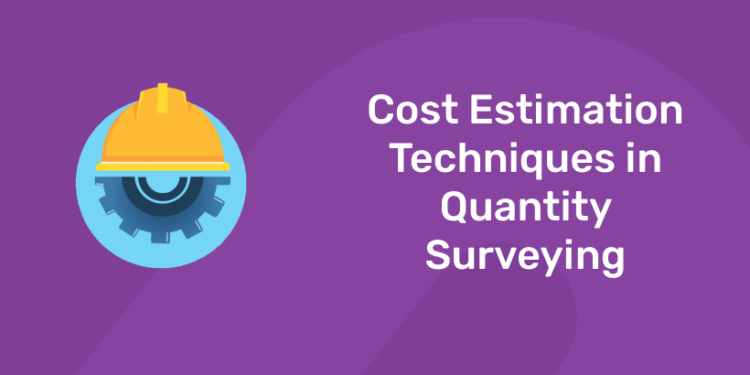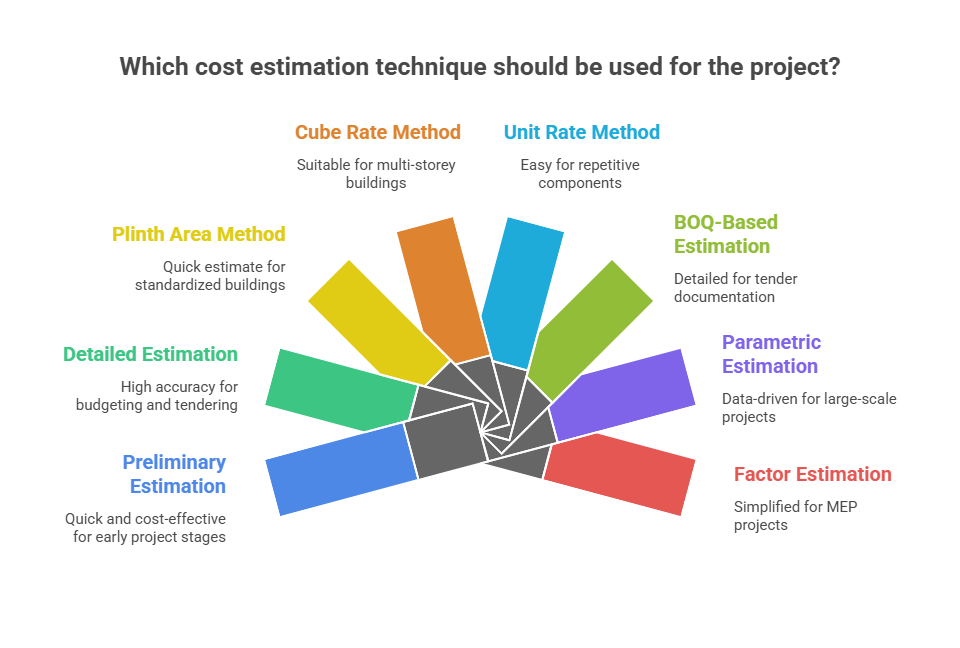Table of Contents
In construction cost estimation is the backbone of budgeting, planning and project delivery. Whether it’s a residential building, highway infrastructure or a multi storey commercial complex, accurate estimation ensures the project is financially viable and sustainable. This is where quantity surveying comes in.
A Quantity Surveyor (QS) estimates project costs, prepares budgets and manages expenditure throughout the construction lifecycle. But how do they do it? The answer lies in a combination of structured methodologies and proven techniques. In this article we’ll look at the top cost estimation techniques used in quantity surveying and how they affect construction projects.
What Is Cost Estimation in Quantity Surveying?
Cost estimation is the process of predicting the cost of resources needed to complete a construction project. It involves calculating:
-
Labour costs
-
Material costs
-
Equipment and plant costs
-
Overheads and profits
-
Contingency allowances
The goal is to ensure that the client receives value for money while the project remains within budget from start to finish.
Importance of Accurate Cost Estimation
1: What is the main purpose of a Bill of Quantities (BoQ)?
Inaccurate estimates can lead to:
-
Budget overruns
-
Project delays
-
Resource shortages
-
Disputes between stakeholders
With proper cost estimation techniques, Quantity Surveyors help project owners make informed decisions, secure funding, negotiate contracts, and monitor cash flow effectively.
Become a skilled Quantity Surveyor and excel in your career! Free Demo Classes Here!
Master Quantity Surveying – Build a Rewarding Career Today!
Gain in-demand skills in cost estimation, project budgeting, and contract management with our Quantity Surveying Course. Learn from industry experts and boost your career in construction and infrastructure. Enroll now and take the first step toward success!
Know MoreTop Cost Estimation Techniques in Quantity Surveying
1. Preliminary or Approximate Estimation
When it’s used: Early project stages (feasibility or concept phase)
Purpose: To provide a ballpark figure for budgeting
Methodology:
-
Based on historical data from similar projects
-
Uses cost per unit area (e.g., per square metre) or per unit volume
Example: Estimating a residential building at ₹1,800/sq.ft.
Pros:
-
Quick and cost-effective
-
Helps assess project feasibility
Cons:
-
Low accuracy
-
Not suitable for detailed planning
✅ Best for: Feasibility studies, early-stage proposals
2. Detailed Estimation (Item-wise Estimation)
When it’s used: After design and drawings are finalised
Purpose: To provide a highly accurate cost breakdown
Methodology:
-
Breaking the project into components (foundation, superstructure, finishes, etc.)
-
Calculating quantities using drawings and specifications
-
Applying unit rates to each item
Tools Used: Excel, CostX, AutoCAD, PlanSwift
Pros:
-
High accuracy
-
Essential for budgeting, tendering, and financial planning
Cons:
-
Time-consuming
-
Requires complete design documentation
✅ Best for: Tendering, budget approval, contractor selection
3. Plinth Area Method
When it’s used: During early planning or comparison between designs
Purpose: To provide a rough estimate based on the area of the building
Methodology:
-
Total built-up area × Plinth area rate (based on similar construction types)
Example: 10,000 sq.ft. × ₹2,000/sq.ft. = ₹2 Crores
Pros:
-
Quick estimation
-
Useful for standardised buildings
Cons:
-
Doesn’t consider variations in design, quality, or location
✅ Best for: Mass housing schemes, public buildings, schools
4. Cube Rate Method
When it’s used: For multi-storey buildings
Purpose: To estimate cost based on building volume
Methodology:
-
Volume of the building × Cube rate per m³
Formula:
Volume = Length × Breadth × Height of building
Total cost = Volume × Rate per m³
Pros:
-
More accurate than plinth area method
-
Suitable for volumetric comparisons
Cons:
-
Still lacks item-wise detail
✅ Best for: High-rise buildings, commercial projects
5. Unit Rate Method
When it’s used: For repetitive or modular construction components
Purpose: To calculate cost based on per-unit measurement
Methodology:
-
Cost = Quantity × Unit Rate
(e.g., 5,000 sq.ft. of tiling @ ₹70/sq.ft. = ₹3.5 lakhs)
Pros:
-
Easy to calculate
-
Ideal for contractors and procurement
Cons:
-
Doesn’t include hidden or indirect costs
✅ Best for: Finishing works, MEP installations, procurement planning
6. BOQ-Based Estimation (Bill of Quantities)
When it’s used: During tendering and project execution
Purpose: To offer detailed cost estimation for every element of work
Methodology:
-
QS prepares BOQ by quantifying each activity/item
-
Contractors quote rates and submit bids based on BOQ
Pros:
-
Standard format
-
Transparency between client and contractor
Cons:
-
Requires accurate drawings and specifications
✅ Best for: Tender documentation, contract negotiation, cost control
7. Parametric Estimation
When it’s used: For infrastructure or large-scale projects
Purpose: Uses mathematical models to predict costs based on parameters
Methodology:
-
Inputs include project size, location, materials, and complexity
-
Uses regression analysis or software algorithms
Pros:
-
Data-driven
-
Ideal for large public or PPP projects
Cons:
-
Requires strong historical data and software skills
✅ Best for: Highways, airports, railways, industrial plants
8. Factor Estimation
When it’s used: For MEP and industrial projects
Purpose: Applies factors to a known cost component to estimate total project cost
Methodology:
-
Multiply base cost (e.g., equipment) by factor (e.g., 4×)
Example: Machinery cost = ₹1 Cr; Total estimated project cost = ₹4 Cr
Pros:
-
Simplified method
-
Saves time for MEP-heavy projects
Cons:
-
Less reliable for civil projects
✅ Best for: Mechanical, electrical, and industrial cost planning
Comparison Table: Cost Estimation Techniques in Quantity Surveying
| Technique | Accuracy | Time Required | Used For |
|---|---|---|---|
| Preliminary Estimate | Low | Low | Feasibility studies |
| Detailed Estimate | High | High | Budgeting, execution |
| Plinth Area Method | Medium | Low | Residential buildings |
| Cube Rate Method | Medium | Medium | Multi-storey buildings |
| Unit Rate Method | High | Medium | Procurement, costing |
| BOQ Method | High | High | Tendering, project control |
| Parametric Estimate | Medium-High | Medium | Infrastructure, complex projects |
| Factor Estimate | Medium | Low | MEP and industrial projects |
Start a rewarding career in Quantity Surveying! Book for Free Demo Classes Here!
Benefits of Effective Cost Estimation in Quantity Surveying
- Prevents Overruns: Accurate estimates reduce budget deviations by 15–20%.
- Enhances Stakeholder Trust: Transparent BOQs and reports build confidence.
- Optimizes Resources: Saves 10% on material costs through value engineering.
- Supports Bidding: Competitive estimates win tenders in India’s NHAI or UAE’s infrastructure projects.
- Boosts Employability: QS professionals with estimation skills are in high demand, with 30% job growth in the Middle East.
Master Quantity Surveying – Build a Rewarding Career Today!
Gain in-demand skills in cost estimation, project budgeting, and contract management with our Quantity Surveying Course. Learn from industry experts and boost your career in construction and infrastructure. Enroll now and take the first step toward success!
Know MoreTools and Technologies for Cost Estimation
- PlanSwift: Digital quantity takeoff for Preliminary and Unit Rate Estimation.
- Primavera P6: Scheduling and cost tracking for Detailed and Bottom-Up Estimation.
- AutoCAD/BIM: Precise quantity extraction for Detailed Estimation.
- Excel/CostX: Data analysis for Parametric and Unit Rate Estimation.
Entri’s Contribution: Entri’s Quantity Surveying Course trains on these tools, ensuring readiness for Indian and Middle East projects.
Want to Learn Quantity Surveying?
If you’re a civil engineering student or working professional looking to build a career in construction costing and estimation, mastering these techniques is key.
🔹 Learn from Industry Experts with Entri
The Entri Quantity Surveying Course covers:
-
Estimation methods with hands-on examples
-
Rate analysis and cost breakdowns
-
Billing and documentation practices
-
Software training (Excel, AutoCAD, BOQ formats)
-
Certification and job readiness
👉 Join Entri’s Quantity Surveyor Course Now and start your journey toward a high-demand career!
Conclusion
Cost estimation is not just about numbers, it’s about strategy, accuracy, and control. For Quantity Surveyors, mastering various estimation techniques is essential to maintain financial discipline and deliver successful construction projects. Whether you are preparing a tender, managing a mega infrastructure project, or planning a residential layout, the right estimation technique can make all the difference.
Master Quantity Surveying – Build a Rewarding Career Today!
Gain in-demand skills in cost estimation, project budgeting, and contract management with our Quantity Surveying Course. Learn from industry experts and boost your career in construction and infrastructure. Enroll now and take the first step toward success!
Know MoreFrequently Asked Questions
What is cost estimation in Quantity Surveying?
Cost estimation is the process of forecasting project costs for materials, labor, and equipment to ensure budget accuracy.
Which technique is best for early-stage projects?
Preliminary Estimation, using historical data for quick budgets.
How accurate is Detailed Estimation?
Detailed estimation provides an accuracy of ±5–10%, ideal for final contracts and mega-projects.
What tools are used for Unit Rate Estimation?
PlanSwift, Excel, and IS codes for BOQ preparation.
Is Entri’s Quantity Surveying Course beginner-friendly?
Yes, it requires no prior experience; checkout full details here: entri.app.
Which is the most accurate method of cost estimation?
The detailed estimation method using item-wise breakdowns and BOQ is the most accurate, especially during tendering.
Are software tools necessary for cost estimation?
Yes, tools like Excel, AutoCAD, CostX, and MS Project streamline the process and reduce manual errors.
Can a beginner learn cost estimation techniques?
Absolutely! Courses like Entri’s provide beginner-friendly modules with practical examples.
How does cost estimation reduce construction risk?
Accurate estimates help allocate budgets correctly, forecast resource needs, and reduce unexpected financial shocks.

























